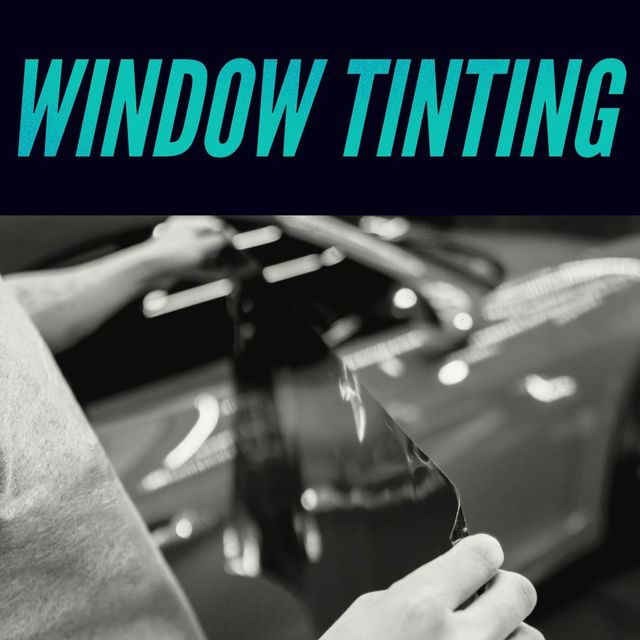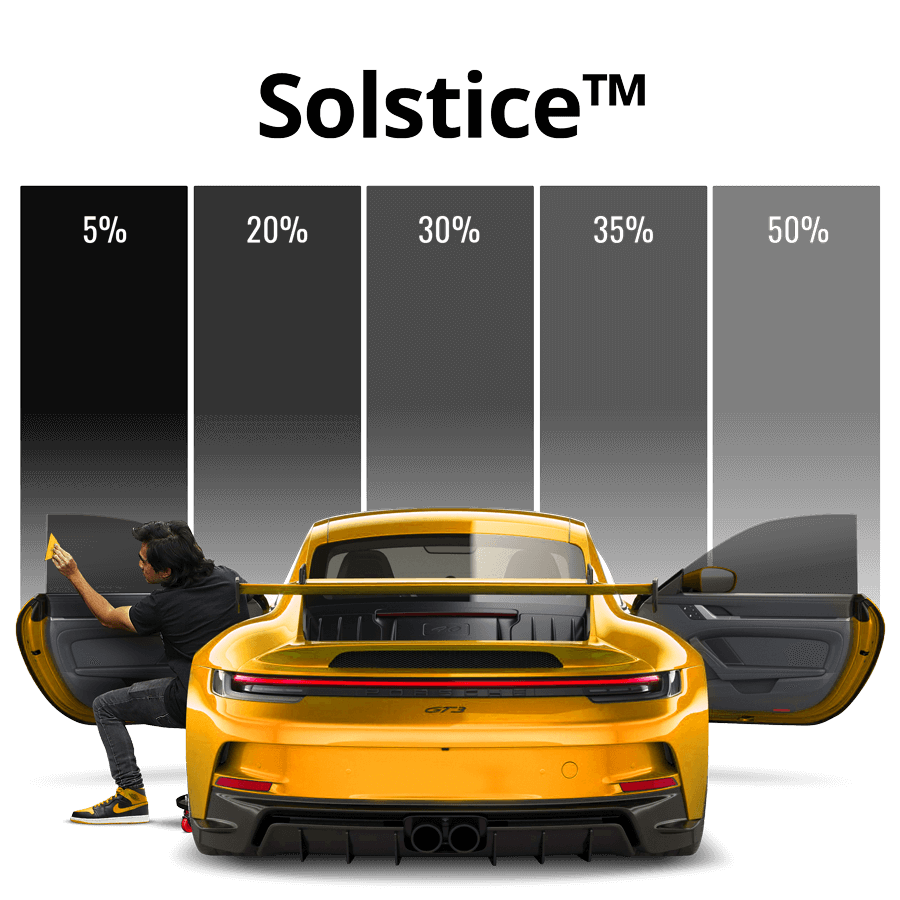A Comprehensive Guide to Recognizing Automobile Window Tint and Its Advantages
Vehicle home window tinting offers greater than simply a visual objective for cars. It supplies numerous types, each with distinctive functions and benefits. Comprehending these alternatives, in addition to legal guidelines and maintenance tips, is essential for any kind of lorry proprietor. The benefits might substantially enhance driving comfort and car longevity. As one discovers the nuances of home window tinting, the question emerges: what kind of tint is finest fit for private needs?
Comprehending Auto Home Window Tint: What It Is and Exactly how It Functions
Vehicle window tint works as a protective barrier that boosts automobile aesthetics while giving useful advantages. This slim movie is put on the indoor surface area of cars and truck windows, reducing glare and obstructing damaging ultraviolet (UV) rays from the sunlight. By filtering sunshine, vehicle window color assists to manage the interior temperature level of the car, causing boosted convenience for guests and lowered reliance on air conditioning.Additionally, it protects the vehicle's inside from fading, protecting both furniture and control panel products. The tint can additionally improve personal privacy, making it harder for outsiders to see inside the lorry. Certain kinds of home window color can increase safety and security; in the occasion of a mishap, the film assists hold destroyed glass with each other, lowering the threat of injury from flying shards. Overall, automobile home window color serves both useful and aesthetic functions, making it a preferred choice among lorry proprietors.
Kinds Of Home Window Tint: An Introduction of Options
When taking into consideration window tint choices, numerous types are available, each with distinctive attributes. Dyed, metalized, and ceramic home window colors offer varying degrees of heat denial, UV security, and visual allure. Comprehending these differences can assist vehicle proprietors make educated selections based on their demands and preferences.
Colored Home Window Tint
Dyed home window tint represents a preferred choice among automobile proprietors seeking a efficient and budget friendly way to boost their car's visual appeals and privacy. This type of tint is produced by positioning a layer of color between an adhesive layer and a safety coating, causing a dark appearance that reduces glare and improves aesthetic comfort. While colored window tint efficiently obstructs dangerous UV rays, it may not provide the very same level of warmth rejection as other tint types. Furthermore, its shade can discolor gradually, possibly diminishing its effectiveness. Regardless of these drawbacks, colored home window color remains popular for its cost-effectiveness and capacity to supply a streamlined, stylish want to different lorry models.
Metalized Home Window Color
Metalized home window tint offers a balance of style and functionality, making it a preferred selection among vehicle proprietors. This sort of color includes metallic fragments within the film, improving both aesthetic allure and heat denial. The reflective quality of metalized color aids to minimize glow and improve personal privacy, while also providing UV protection, which safeguards the vehicle's inside. Additionally, metalized home window color can enhance home window strength, possibly avoiding smashing throughout accidents. However, it is very important to note that the metallic parts can disrupt digital signals, such as GPS and cellular phone reception. In general, metalized window tint gives an efficient service for those looking for a mix of sun, appearance, and durability security for their automobiles.
Ceramic Home Window Color
Ceramic window color represents an innovative option in the spectrum of auto home window films, providing distinctive advantages over traditional tints. Unlike dyed or metalized movies, ceramic tints make use of advanced ceramic fragments, which properly turn down heat and UV rays without jeopardizing presence. This modern technology assures that lorries stay cooler, reducing dependence on a/c and improving fuel performance. Additionally, ceramic home window colors are much less likely to hinder digital tools, such as GPS or mobile signals, making them a functional selection for modern-day lorries. Furthermore, their longevity and scratch resistance add to a longer lifespan contrasted to other sorts of colors. Generally, ceramic window color offers superior performance, comfort, and protection, making it a recommended alternative for discerning automobile proprietors.
Benefits of Automobile Home Window Color: Beyond Looks
While lots of people associate auto window color with improved style, its benefits prolong far beyond plain aesthetic appeals. One substantial benefit is warm reduction; home window tint can obstruct approximately 99% of hazardous UV rays, maintaining the interior colder and securing upholstery from fading. This not just improves convenience throughout heat but also minimizes reliance on cooling, causing enhanced fuel efficiency.In addition, vehicle home window color provides an included layer of personal privacy and safety and security. Tinted home windows make it tough for outsiders to see inside the vehicle, which can deter burglary and secure prized possessions. Furthermore, several colors reinforce the glass, minimizing the possibility of shattering in case of an accident, thereby improving safety.In enhancement to these practical benefits, auto home window color can also contribute to glare reduction, improving presence for guests and drivers alike. This multifaceted technique to comfort and safety makes window tint an important financial investment for lorry owners.
Lawful Factors To Consider: Tinting Regulations by State
Before devoting to auto window tint, vehicle owners should navigate a complex landscape of tinting laws that differ by state. Each state has certain laws controling the acceptable levels of tint darkness and reflectivity for various home windows, consisting of windshields, front side windows, and rear home windows. These laws often include noticeable light transmission (VLT) percents, which dictate just how much light can go through the tinted glass.Some states permit darker colors on back home windows while limiting front side and windshield tints for safety and security factors. Furthermore, specific states may require a certification from the producer get more info to verify compliance with tinting regulations. Violating these guidelines can lead to penalties, required elimination of the tint, or both. It is crucial for lorry proprietors to research their state's regulations thoroughly to assure legal conformity prior to setting up window color. This diligence can save money and time in the future.
Selecting the Right Tint: Variables to Consider
When selecting the appropriate window tint for an automobile, several important variables enter play. Color darkness levels, UV defense scores, and compliance with legal laws are important factors to consider to ensure both aesthetics and capability. Evaluating these facets will certainly aid individuals make an educated choice that meets their requirements and follows local regulations.
Tint Darkness Levels
Selecting the appropriate color darkness level is important for accomplishing the desired equilibrium between looks and capability in vehicle window tinting. Various states have varying legal regulations relating to color darkness, which can influence the choice. Typically, tints are gauged in portions, with reduced percents suggesting darker tones. Darker tints offer boosted privacy and a streamlined look yet can lower exposure, particularly at evening. Conversely, lighter colors keep a more open feeling, making sure appropriate presence while still giving some heat and glare decrease. Individuals ought to consider their driving habits, local legislations, and personal choices when deciding. Ultimately, the right tint darkness level improves the lorry's appearance while making sure safety and security and compliance with legal standards.
UV Defense Ranking
Tint darkness levels play a considerable duty in the total effectiveness of vehicle home window tinting, but one more important element to assess is the UV security ranking of the selected tint. This rating suggests the percent of hazardous ultraviolet rays that the color can block. Top quality tints commonly give 99% or even more UV protection, protecting guests and the vehicle's interior from sun damages. Davinci of Michigan. Prolonged exposure to UV rays can cause skin troubles and fading of upholstery, making a high UV protection ranking crucial for health and wellness and long life. When choosing window tint, consumers must prioritize this score along with darkness degrees to ensure optimum convenience and security while driving. Comprehending these elements aids in making a notified choice when buying vehicle home window tinting
Lawful Regulations Conformity
Recognizing neighborhood legal laws is crucial for any person thinking about automobile window tinting. Each state or area has certain laws regulating the allowed degrees of color darkness and reflectivity for various windows. These regulations often specify the visible light transmission portion, establishing just how much light can pass through the colored glass. Non-compliance can cause fines, necessary removal of the tint, or issues during automobile assessments. Additionally, some areas might have constraints on the use of specific tinting products, needing consumers to choose items that fulfill safety and security criteria. It is crucial for lorry owners to research their regional regulations extensively before picking home window color to guarantee compliance and prevent potential legal complications.

Installation Process: do it yourself vs. Expert Solutions
Just how does one determine in between a do it yourself installment and hiring expert services for car home window tinting? The choice usually depends upon budget, experience, and desired results. A do it yourself technique can be economical, allowing individuals to minimize labor expenses. However, it requires a specific level of ability and knowledge regarding the tinting procedure. Those who are precise and client might find success with do it yourself sets available in the market.Conversely, professional services supply competence and high-quality products, making sure a perfect finish. Professionals often ensure their work, giving assurance against potential problems such as peeling off or bubbling. Additionally, they know with regional laws regarding tinting, which can be intricate for the typical car owner.Ultimately, the decision reflects a balance between price, personal capacity, and the anticipated quality of the tinting job. Each option has its benefits, and the very best choice depends on private conditions and preferences.
Upkeep Tips: Maintaining Your Tint in Leading Condition

Often Asked Concerns
The Length Of Time Does Home Window Color Usually Last on a Lorry?
Window tint generally lasts in between 5 to 10 years, depending on variables such as high quality, application, and ecological problems. Regular upkeep and appropriate care can prolong its life expectancy, ensuring excellent performance and appearance in time.
Can Window Tinting Damage My Vehicle's Original Glass?
Window tinting, when applied appropriately, does not damage a cars and truck's original glass. Improper installment or low-grade materials might lead to problems like gurgling or peeling off, potentially influencing the glass's integrity over time.
Is Window Tinting Safe for All Sorts Of Autos?
Window tinting is usually secure for most automobiles, provided the film conforms with regional regulations and is effectively used. Nevertheless, some specialized cars might need specific considerations, making it important to get in touch with professionals prior to installation.
Will Window Tinting Gap My Cars And Truck Guarantee?
The concern of whether window tinting spaces an auto warranty typically depends on the manufacturer's plans. Normally, if the color does not harm the car, guarantees commonly stay undamaged. However, consulting the dealership is a good idea.
Can I Get Rid Of Window Color Myself if Needed?
Eliminating window tint oneself is feasible, however it calls for careful focus to avoid harming the glass. People must utilize proper tools and techniques to guarantee a successful elimination without leaving adhesive residue or scratches behind. While dyed home window color successfully obstructs harmful UV rays, it may not offer the exact same level of warm rejection as various other tint types. Ceramic window color stands for an innovative option in the range of automotive home window films, supplying unique benefits over traditional colors. Before devoting to automobile window tint, vehicle owners have to navigate a complex landscape of tinting laws that vary by state. These guidelines frequently include visible light transmission (VLT) portions, which dictate exactly how much light can pass via the colored glass.Some states permit darker tints on rear windows while restricting front side and windshield tints for security factors. Color darkness degrees play a considerable function in the overall efficiency of vehicle home window tinting, however another crucial factor to assess is the UV security rating of the selected tint.